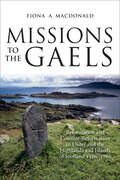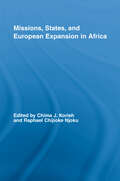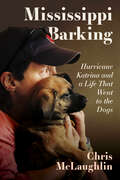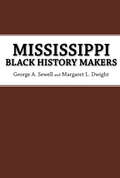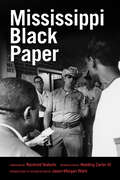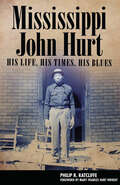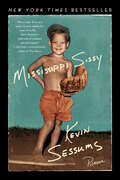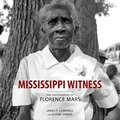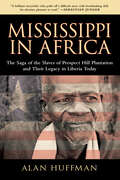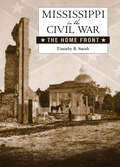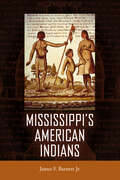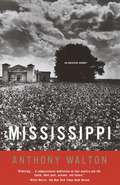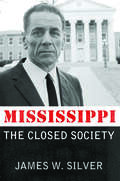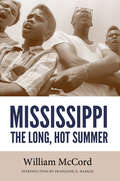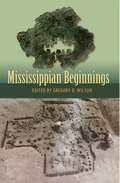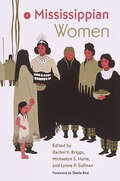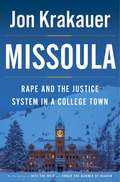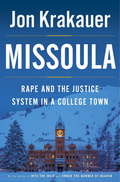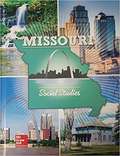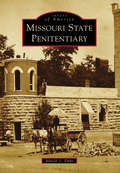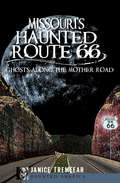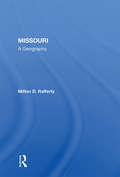- Table View
- List View
Missions to the Gaels: Reformation and Counter-Reformation in Ulster and the Highlands and Islands of Scotland 1560–1760
by Fiona A. MacDonaldThis book is an extended study, in the Post-Reformation period, of the impact of the Gaels in the west of Scotland and the north of Ireland on each other’s religious heritage. Beginning half a century before the plantation of Ulster, Missions to the Gaels illuminates the origins of the sectarian divisions in Northern Ireland. The research deals with both Protestants and Catholics, rather than treating only one denomination in isolation. The author explores the intriguing situation whereby Scottish Gaelic-speaking ministers laid the foundations of the embryonic Protestant Church in Ireland, while at the same time Irish-speaking priests were almost exclusively responsible for the reintroduction of Catholicism to the Highlands and Islands of Scotland. The range of this book extends beyond narrow ecclesiastical issues: it reveals the broader political and cultural forces that determined the Gaels’ choice of religious alignment and traces the effects of these over two centuries of turbulent change in Gaelic society.
Missions, States, and European Expansion in Africa (African Studies)
by Raphael Chijioke Njoku Chima J. KoriehMissions, States, and European Expansion in Africa aims to explore the ways Christianity and colonialism acted as hegemonic or counter hegemonic forces in the making of African societies. As Western interventionist forces, Christianity and colonialism were crucial in establishing and maintaining political, cultural, and economic domination. Indeed, both elements of Africa’s encounter with the West played pivotal roles in shaping African societies during the nineteenth and twentieth centuries. This volume uses a wide range of perspectives to address the intersection between missions, evangelism, and colonial expansion across Africa. The contributors address several issues, including missionary collaboration with the colonizing effort of European powers; disagreements between missionaries and colonizing agents; the ways in which missionaries and colonial officials used language, imagery, and European epistemology to legitimize relations of inequality with Africans; and the ways in which both groups collaborated to transform African societies. Thus, Missions, States, and European Expansion in Africa transcends the narrow boundaries that often separate the role of these two elements of European encounter to argue that missionary endeavours and official colonial actions could all be conceptualized as hegemonic institutions, in which both pursued the same civilizing mission, even if they adopted different strategies in their encounter with African societies.
Mississippi Barking: Hurricane Katrina and a Life That Went to the Dogs
by Chris McLaughlinWinner of a 2023 Best Book Award in the category of Animals/Pets: Narrative Nonfiction from American Book FestOn August 29, 2005, the worst natural disaster in the history of the United States devastated the city of New Orleans and the Gulf Coast of Louisiana and Mississippi. Like many others in America and around the world, Chris McLaughlin watched the tragedy of Katrina unfold on a television screen from the comfort of her living room on Cape Cod in Massachusetts. In the devastation afterwards, almost 2,000 people and an estimated 250,000 animals had perished. Miraculously, many pets did manage to survive. But in the months that followed the hurricane, thousands of them were fending for themselves in the ruins of devastated neighborhoods. They roamed the streets in feral packs or struck out alone. Their plight triggered a grassroots rescue effort unlike any this country had ever seen, and while relief organizations such as the Red Cross were tending to the human survivors, and movie stars and celebrities were airlifting food and endorsing seven-figure checks, a much smaller and meagerly funded effort was underway to save the four-legged victims. With no prior experience in disaster response and no real grasp of the hell that awaited them, scores of animal lovers, including McLaughlin, made their way to the Gulf Coast to help in any way they could. Including photos from four-time Pulitzer Prize–winning photojournalist Carol Guzy, Mississippi Barking spans the course of two years as McLaughlin and others ventured into the wreckage of the Gulf Coast to rescue the animals left behind. McLaughlin tells the moving stories of the people she met along the way, both those who lost everything to the hurricane and those working beside her rescuing and transporting animals away from the neglected, derelict conditions in which they barely survived. Within this story of tragedy and cruelty, suffering and ignorance, Mississippi Barking also bears witness to selfless acts of bravery and compassion, and the beauty and heroics of those who risked everything to save the animals that could not save themselves.
Mississippi Black History Makers
by George A. Sewell Margaret L. DwightThis book of biographical sketches of notable African Americans from Mississippi includes a total of 166 figures, all who have made significant contributions.Black history makers are defined herein as those who have achieved national prominence in their fields, who have made lasting contributions within the state as pioneers in their fields, or who contributed to their own communities or fields as role models. Each of those included in the book either was born in Mississippi, spent a part of their childhood there, or migrated to Mississippi and remained. History makers covered include Hiram R. Revels, the first Black US Senator; Blanche K. Bruce, the first Black US Senator to serve a six-year term; political and civil rights leaders such as Aaron Henry, Medgar Evers, and Fannie Lou Hamer; William Johnson, a free Black man from antebellum Natchez; Margaret Murray Washington, wife of Booker T. Washington; Walter Payton, former running back for the Chicago Bears; and contributors to arts and letters such as Leontyne Price, William Grant Still, Margaret Walker Alexander, James Earl Jones, and “Bo Diddley” McDaniel, a pioneer rock-and-roll musician; as well as other notable Black Mississippians. The book is organized into ten thematic sections: politics, civil rights, business, education, performing and visual arts, journalism and literature, military, science/medicine/social work, sports, and religion. And each section is introduced by an historical overview of this field in the state of Mississippi. This book is a valuable reference work for those wishing to assess the contributions of African Americans to the history of Mississippi. Of particular significance is the fact that it is a collection which brings attention to lesser-known figures as well as those of considerable renown.
Mississippi Black Paper (Civil Rights in Mississippi Series)
by Reinhold Niebuhr, Hodding Carter III and Jason Morgan WardAt the height of the civil rights movement in Mississippi, as hundreds of volunteers prepared for the 1964 Freedom Summer Project, the Council of Federated Organizations (COFO) compiled hundreds of statements from activists and everyday citizens who endured police abuse and vigilante violence. Fifty-seven of those testimonies appear in Mississippi Black Paper. The statements recount how white officials and everyday citizens employed assassinations, beatings, harassment, and petty meanness to block any change in the state's segregated status quo. The testimonies in Mississippi Black Paper come from well-known civil rights heroes such as Fannie Lou Hamer, Aaron Henry, and Rita Schwerner, but the book also brings new voices and stories to the fore. Alongside these iconic names appear grassroots activists and everyday people who endured racial terror and harassment for challenging, sometimes in seemingly imperceptible ways, the state's white supremacy. This new edition includes the original foreword by Reinhold Neibuhr and the original introduction by Mississippi journalist Hodding Carter III, as well as Jason Morgan Ward's new introduction that places the book in its context as a vital source in the history of the civil rights movement.
Mississippi John Hurt: His Life, His Times, His Blues (American Made Music Series)
by Philip R. RatcliffeWinner, Best History, 2012 Association for Recorded Sound Collections Award for Excellence in Historical Recorded Sound ResearchWhen Mississippi John Hurt (1892-1966) was "rediscovered" by blues revivalists in 1963, his musicianship and recordings transformed popular notions of prewar country blues. At seventy-one he moved to Washington, D.C., from Avalon, Mississippi, and became a live-wire connection to a powerful, authentic past. His intricate and lively style made him the most sought after musician among the many talents the revival brought to light.Mississippi John Hurt provides this legendary creator's life story for the first time. Biographer Philip Ratcliffe traces Hurt's roots to the moment his mother Mary Jane McCain and his father Isom Hurt were freed from slavery. Anecdotes from Hurt's childhood and teenage years include the destiny-making moment when his mother purchased his first guitar for $1.50 when he was only nine years old. Stories from his neighbors and friends, from both of his wives, and from his extended family round out the community picture of Avalon. US census records, Hurt's first marriage record in 1916, images of his first autographed LP record, and excerpts from personal letters written in his own hand provide treasures for fans. Ratcliffe details Hurt's musical influences and the origins of his style and repertoire. The author also relates numerous stories from the time of his success, drawing on published sources and many hours of interviews with people who knew Hurt well, including the late Jerry Ricks, Pat Sky, Stefan Grossman and Max Ochs, Dick Spottswood, and the late Mike Stewart. In addition, some of the last photographs taken of the legendary musician are featured for the first time in Mississippi John Hurt.
Mississippi Sissy
by Kevin Sessums“A book I’ve been waiting for most of my life . . . by a writer who is equally at home with Flannery O’Connor and Jacqueline Susann.” —Michael Cunningham, Pulitzer Prize–winning author Mississippi Sissy is the stunning memoir from Kevin Sessums, a celebrity journalist who grew up scaring other children, hiding terrible secrets, pretending to be Arlene Frances and running wild in the South.As he grew up in Forest, Mississippi, befriended by the family maid, Mattie May, he became a young man who turned the word “sissy” on its head, just as his mother taught him. In Jackson, he is befriended by Eudora Welty and journalist Frank Hains, but when Hains is brutally murdered in his antebellum mansion, Kevin’s long road north towards celebrity begins. In his memoir, Kevin Sessums brings to life the pungent American south of the 1960s and the world of the strange little boy who grew there.“Mississippi Sissy is an unforgettable memoir. I think it will strike a strong chord with many, many readers. It’s a far different book than Midnight in the Garden of Good and Evil, but it cast the same kind of spell over me while I was reading it.” —Mark Childress, author of Georgia Bottoms“What a writer! What honesty! Kevin Sessums seamlessly weaves his heart-breaking, funny, outrageous, can’t-put-it-down story. Read it! Read it! Read it! Then read it again.” —Ellen DeGeneres“Kevin Sessums is a brilliant writer. He is also a courageous one. Mississippi Sissy is beautifully told—hilarious yet harrowing, tragic yet inspiring. This book will deeply touch anyone who has ever felt different, which means every single one of us.” —E. Lynn Harris, New York Times–bestselling author
Mississippi Solo: A River Quest
by Eddy Harris Eddy L. HarrisSince the publication of his first book, Mississippi Solo, Eddy L. Harris has been praised for his travel writing. In this exciting reissue of his classic travelogue, readers will come to treasure the rich insightful prose that is as textured as the Mississippi River itself. They will be taken by the hand by an adventurer whose lifelong dream is to canoe the length of this mighty river, from Minnesota to New Orleans. The trip's dangers were legion for a Black man traveling alone, paddling from "where there ain't no black folks to where they still don't like us much." Barge waives loom large, wild dogs roam the wooded shores, and, in the Arkansas dusk, two shotgun-toting bigots nearly bring the author's dream to a bloody . Sustaining him through the hard weeks of paddling were the hundreds of people who reached out to share a small piece of his challenge. Mississippi Solo is a big, rollicking, brilliant book, a wonderful piece of American adventure, and an unforgettable story of a man testing his own limits.
Mississippi Witness: The Photographs of Florence Mars
by James T. Campbell Elaine OwensIn June 1964, Neshoba County, Mississippi, provided the setting for one of the most notorious crimes of the civil rights era: the Klan-orchestrated murder of three young voting-rights workers, James Chaney, Michael Schwerner, and Andrew Goodman. Captured on the road between the towns of Philadelphia and Meridian, the three were driven to a remote country crossroads, shot, and buried in an earthen dam, from which their bodies were recovered after a forty-four-day search.The crime transfixed the nation. As federal investigators and an aroused national press corps descended on Neshoba County, white Mississippians closed ranks, dismissing the men’s disappearance as a “hoax” perpetrated by civil rights activists to pave the way for a federal “invasion” of the state. In this climate of furious conformity, only a handful of white Mississippians spoke out. Few did so more openly or courageously than Florence Mars. A fourth-generation Neshoban, Mars braved social ostracism and threats of violence to denounce the murders and decry the climate of fear and intimidation that had overtaken her community. She later recounted her experiences in Witness in Philadelphia, one of the classic memoirs of the civil rights era. Though few remember today, Mars was also a photographer. Shocked by the ferocity of white Mississippians’ reaction to the Supreme Court’s 1954 ruling against racial segregation, she bought a camera, built a homemade darkroom, and began to take pictures, determined to document a racial order she knew was dying. Mississippi Witness features over one hundred of these photographs, most taken in the decade between 1954 and 1964, almost all published here for the first time. While a few depict public events—Mars photographed the 1955 trial of the murderers of Emmett Till—most feature private moments, illuminating the separate and unequal worlds of black and white Mississippians in the final days of Jim Crow.Powerful and evocative, the photographs in Mississippi Witness testify to the abiding dignity of human life even in conditions of cruelty and deprivation, as well as to the singular vision of one of Mississippi’s—and the nation’s—most extraordinary photographers.
Mississippi Zion: The Struggle for Liberation in Attala County, 1865–1915
by Evan Howard AshfordRECIPIENT OF THE 2023 BOOK OF THE YEAR AWARD FROM THE MISSISSIPPI HISTORICAL SOCIETYRECIPIENT OF THE ANNA JULIA COOPER AND C. L. R. JAMES AWARD FOR OUTSTANDING SCHOLARLY PUBLICATION IN AFRICANA STUDIES FROM THE NATIONAL COUNCIL FOR BLACK STUDIES2023 ASALH BOOK PRIZE FINALISTFrom lesser-known state figures to the ancestors of Oprah Winfrey, Morgan Freeman, and James Meredith, Mississippi Zion: The Struggle for Liberation in Attala County, 1865–1915 brings the voices and experiences of everyday people to the forefront and reveals a history dictated by people rather than eras. Author Evan Howard Ashford, a native of the county, examines how African Americans in Attala County, after the Civil War, shaped economic and social politics as a nonmajority racial group. At the same time, Ashford provides a broader view of Black life occurring throughout the state during the same period. By examining southern African American life mainly through Reconstruction and the civil rights movement, historians have long mischaracterized African Americans in Mississippi by linking their empowerment and progression solely to periods of federal assistance. This book shatters that model and reframes the postslavery era as a Liberation Era to examine how African Americans pursued land, labor, education, politics, community building, and progressive race relations to position themselves as societal equals. Ashford salvages Attala County from this historical misconception to give Mississippi a new history. He examines African Americans as autonomous citizens whose liberation agenda paralleled and intersected the vicious redemption agenda, and he shows the struggle between Black and white citizens for societal control. Mississippi Zion provides a fresh examination into the impact of Black politics on creating the anti-Black apparatuses that grounded the state’s infamous Jim Crow society. The use of photographs provides an accurate aesthetic of rural African Americans and their connection to the historical moment. This in-depth perspective captures the spectrum of African American experiences that contradict and refine how historians write, analyze, and interpret southern African American life in the post-slavery era.
Mississippi in Africa: The Saga of the Slaves of Prospect Hill Plantation and Their Legacy in Liberia Today
by Alan HuffmanWhen wealthy Mississippi cotton planter Isaac Ross died in 1836, his will decreed that his plantation, Prospect Hill, should be liquidated and the proceeds from the sale be used to pay for his slaves' passage to the newly established colony of Liberia in western Africa. Ross's heirs contested the will for more than a decade, prompting a deadly revolt in which a group of slaves burned Ross's mansion to the ground. But the will was ultimately upheld. The slaves then emigrated to their new home, where they battled the local tribes and built vast plantations with Greek Revival-style mansions in a region the Americo-Africans renamed “Mississippi in Africa.”In the late twentieth century, the seeds of resentment sown over a century of cultural conflict between the colonists and tribal people exploded, begetting a civil war that rages in Liberia to this day. Tracking down Prospect Hill's living descendants, deciphering a history ruled by rumor, and delivering the complete chronicle in riveting prose, journalist Alan Huffman has rescued a lost chapter of American history whose aftermath is far from over.
Mississippi in the Civil War: The Home Front (Heritage of Mississippi Series)
by Timothy B. SmithIn Mississippi in the Civil War: The Home Front, Timothy B. Smith examines Mississippi's Civil War defeat by both outside and inside forces. From without, the Union army dismantled the state's political system, infrastructure, economy, and fighting capability. The state saw extensive military operations, destruction, and bloodshed within her borders. One of the most frightful and extended sieges of the war ended in a crucial Confederate defeat at Vicksburg, the capstone to a tremendous Union campaign.As Confederate forces and Mississippi became overwhelmed militarily, the populace's morale began to crumble. Realizing that the enemy could roll unchecked over the state, civilians, Smith argues, began to lose the will to continue the struggle. Many white Confederates chose to return to the Union rather than see continued destruction in the name of a victory that seemed ever more improbable. When the tide turned, Unionists and African Americans boldly stepped up their endeavors. The result, Smith finds, was a state vanquished and destined to endure suffering far into its future.The first examination of the state's Civil War home front in seventy years, this book tells the story of all classes of Mississippians during the war, focusing new light on previously neglected groups such as women and African Americans. The result is a revelation of the heart of a populace facing the devastating impact of total war.
Mississippi's American Indians (Heritage of Mississippi Series)
by James F. Barnett Jr.At the beginning of the eighteenth century, over twenty different American Indian tribal groups inhabited present-day Mississippi. Today, Mississippi is home to only one tribe, the Mississippi Band of Choctaw Indians. In Mississippi's American Indians, author James F. Barnett Jr. explores the historical forces and processes that led to this sweeping change in the diversity of the state's native peoples. The book begins with a chapter on Mississippi's approximately 12,000-year prehistory, from early hunter-gatherer societies through the powerful mound building civilizations encountered by the first European expeditions. With the coming of the Spanish, French, and English to the New World, native societies in the Mississippi region connected with the Atlantic market economy, a source for guns, blankets, and many other trade items. Europeans offered these trade materials in exchange for Indian slaves and deerskins, currencies that radically altered the relationships between tribal groups. Smallpox and other diseases followed along the trading paths. Colonial competition between the French and English helped to spark the Natchez rebellion, the Chickasaw-French wars, the Choctaw civil war, and a half-century of client warfare between the Choctaws and Chickasaws. The Treaty of Paris in 1763 forced Mississippi's pro-French tribes to move west of the Mississippi River. The Diaspora included the Tunicas, Houmas, Pascagoulas, Biloxis, and a portion of the Choctaw confederacy. In the early nineteenth century, Mississippi's remaining Choctaws and Chickasaws faced a series of treaties with the United States government that ended in destitution and removal. Despite the intense pressures of European invasion, the Mississippi tribes survived by adapting and contributing to their rapidly evolving world.
Mississippi: An American Journey (Vintage Departures)
by Anthony WaltonRaised in suburban Illinois in the 60s, a gifted student and athlete, Anthony Walton went on to Notre Dame and Brown into a career in journalism -- all the while convinced that racism, insofar as it still existed, was on the way out. Covering the racial flash points in New York in the early 80s, though, led him to feel that racism was the marrow in the American bone, and getting worse all the time. Anthony finally realized this was a demon he had to stare in the face -- which, for him, meant going "home" to Mississippi, where his parents came from and, before his birth, escaped. Still, childhood visits to relatives who stayed gave him the stuff of which nightmares are made. Yet only by learning at last his own heritage could he discover his place and his country's nature. "Mississippi -- perhaps the most loaded proper noun in American English. " What his journey covers is 200 years of history and a huge roster of famous writers, martyrs, bigots, planters and sharecroppers, bluesmen, aristocrats and plain folk, black and white together -- from those who made the history to those who inhabit it today. Neither travelogue nor lay history, neither memoir nor reportage,Mississippiis a powerful narrative that uses one place saturated in blood and lore -- what Southerners call "the South's South" -- to explore "the tragedies the past and our compulsions have visited upon us, all of us. " A book of tremendous literary and social importance.
Mississippi: The Closed Society
by James W. SilverMississippi: The Closed Society is a book about an insurrection in modern America, more particularly, about the social and historical background of that insurrection. It is written by a Mississippian who is a historian, and who, on September 30, 1962, witnessed the long night of riot that exploded on the campus of the University of Mississippi at Oxford, when students, and, later, adults with no connection with the University, attacked United States marshals sent to the campus to protect James H. Meredith, the first African American to attend Ole Miss. In the first part of Mississippi: The Closed Society, Silver describes how the state's commitment to the doctrine of white supremacy led to a situation in which the Mississippian found that continued intransigence (and possibly violence) was the only course offered to him. In these chapters the author speaks in the more formal measures of the historian. In the second part of the book, “Some Letters from the Closed Society,” he reproduces (among other correspondence and memoranda) a series of his letters to friends and family—and critics—in the days and weeks after the insurrection. Here he reveals himself more personally and forcefully. In both parts of the book are disclosed the mind and heart of the Mississippian who is as haunted as William Faulkner was by the moral chaos of his native land.
Mississippi: The Long, Hot Summer (Civil Rights in Mississippi Series)
by William McCordIn 1964, sociologist William McCord, long interested in movements for social change in the United States, began a study of Mississippi's Freedom Summer. Stanford University, where McCord taught, had been the site of recruiting efforts for student volunteers for the Freedom Summer project by such activists as Robert Moses and Allard Lowenstein. Described by his wife as “an old-fashioned liberal,” McCord believed that he should both examine and participate in events in Mississippi. He accompanied student workers and black Mississippians to courthouses and Freedom Houses, and he attracted police attention as he studied the mechanisms of white supremacy and the black nonviolent campaign against racial segregation. Published in 1965 by W. W. Norton, his book, Mississippi: The Long, Hot Summer, is one of the first examinations of the events of 1964 by a scholar. It provides a compelling, detailed account of Mississippi people and places, including the thousands of student workers who found in the state both opportunities and severe challenges. McCord's work sought to communicate to a broad audience the depth of repression in Mississippi. Here was evidence of the need for federal action to address what he recognized as both national and southern failures to secure civil rights for black Americans. His field work and activism in Mississippi offered a perspective that few other academics or other white Americans had shared. Historian Françoise N. Hamlin provides a substantial introduction that sets McCord's work within the context of other narratives of Freedom Summer and explores McCord's broader career that combined distinguished scholarship with social activism.
Mississippian Beginnings (Florida Museum of Natural History: Ripley P. Bullen Series)
by Gregory D. WilsonUsing fresh evidence and nontraditional ideas, the contributing authors of Mississippian Beginnings reconsider the origins of the Mississippian culture of the North American Midwest and Southeast (A.D. 1000–1600). Challenging the decades-old opinion that this culture evolved similarly across isolated Woodland popu¬lations, they discuss signs of migrations, missionization, pilgrimages, violent conflicts, long-distance exchange, and other far-flung entanglements that now appear to have shaped the early Mississippian past. Presenting recent fieldwork from a wide array of sites including Cahokia and the American Bottom, archival studies, and new investigations of legacy collections, the contributors interpret results through contemporary perspectives that emphasize agency and historical contingency. They track the various ways disparate cultures across a sizeable swath of the continent experienced Mississippianization and came to share simi¬lar architecture, pottery, subsistence strategies, sociopolitical organization, iconography, and religion. Together, these essays provide the most comprehensive examination of early Mississippian culture in over thirty years. A volume in the Florida Museum of Natural History: Ripley P. Bullen Series
Mississippian Women (Florida Museum of Natural History: Ripley P. Bullen Series)
by Lynne P. Sullivan Rachel V. Briggs Michaelyn S. HarleHighlighting the role of precontact Indigenous women in building and transforming Mississippian culture This volume highlights how women were powerful farmers, economic decision-makers, spiritual leaders, and agents of social integration in the diverse societies of the Mississippian world, which spanned the present-day United States South to the Midwest before the seventeenth century. While Mississippian societies are some of the most well-researched pre-European contact societies on the continent, little attention has been dedicated specifically to Mississippian women. These chapters offer new insights into the vital role women played within their communities, an approach directly informed by the powerful position of American Indian women within contemporary American Indian communities. Contributors examine themes such as identity, labor, grieving, cooking, craft production, spatial organization, prestige, morbidity, kinship, and fertility. Case studies include sites throughout the Mississippian world, ranging from Illinois to Florida, including Cahokia and Moundville. Mississippian Women is the first volume to focus solely on the political, social, and economic power of women during this period, linking their actions in building their culture before European colonialism with the work of Indigenous women in the region today. A volume in the Florida Museum of Natural History: Ripley P. Bullen Series
Missoula: Rape and the Justice System in a College Town
by Jon KrakauerFrom bestselling author Jon Krakauer, a stark, powerful, meticulously reported narrative about a series of sexual assaults at the University of Montana -- stories that illuminate the human drama behind the national plague of campus rape. Missoula, Montana, is a typical college town, with a highly regarded state university, bucolic surroundings, a lively social scene, and an excellent football team -- the Grizzlies -- with a rabid fan base. The Department of Justice investigated 350 sexual assaults reported to the Missoula police between January 2008 and May 2012. Few of these assaults were properly handled by either the university or local authorities. In this, Missoula is also typical. A DOJ report released in December of 2014 estimates 110,000 women between the ages of eighteen and twenty-four are raped each year. Krakauer's devastating narrative of what happened in Missoula makes clear why rape is so prevalent on American campuses, and why rape victims are so reluctant to report assault. Acquaintance rape is a crime like no other. Unlike burglary or embezzlement or any other felony, the victim often comes under more suspicion than the alleged perpetrator. This is especially true if the victim is sexually active; if she had been drinking prior to the assault -- and if the man she accuses plays on a popular sports team. The vanishingly small but highly publicized incidents of false accusations are often used to dismiss her claims in the press. If the case goes to trial, the woman's entire personal life becomes fair game for defense attorneys. This brutal reality goes a long way towards explaining why acquaintance rape is the most underreported crime in America. In addition to physical trauma, its victims often suffer devastating psychological damage that leads to feelings of shame, emotional paralysis and stigmatization. PTSD rates for rape victims are estimated to be 50%, higher than soldiers returning from war. In Missoula, Krakauer chronicles the searing experiences of several women in Missoula -- the nights when they were raped; their fear and self-doubt in the aftermath; the way they were treated by the police, prosecutors, defense attorneys; the public vilification and private anguish; their bravery in pushing forward and what it cost them. Some of them went to the police. Some declined to go to the police, or to press charges, but sought redress from the university, which has its own, non-criminal judicial process when a student is accused of rape. In two cases the police agreed to press charges and the district attorney agreed to prosecute. One case led to a conviction; one to an acquittal. Those women courageous enough to press charges or to speak publicly about their experiences were attacked in the media, on Grizzly football fan sites, and/or to their faces. The university expelled three of the accused rapists, but one was reinstated by state officials in a secret proceeding. One district attorney testified for an alleged rapist at his university hearing. She later left the prosecutor's office and successfully defended the Grizzlies' star quarterback in his rape trial. The horror of being raped, in each woman's case, was magnified by the mechanics of the justice system and the reaction of the community. Krakauer's dispassionate, carefully documented account of what these women endured cuts through the abstract ideological debate about campus rape. College-age women are not raped because they are promiscuous, or drunk, or send mixed signals, or feel guilty about casual sex, or seek attention. They are the victims of a terrible crime and deserving of compassion from society and fairness from a justice system that is clearly broken.
Missoula: Rape and the Justice System in a College Town
by Jon KrakauerFrom bestselling author Jon Krakauer, a stark, powerful, meticulously reported narrative about a series of sexual assaults at the University of Montana — stories that illuminate the human drama behind the national plague of campus rape Missoula, Montana, is a typical college town, with a highly regarded state university, bucolic surroundings, a lively social scene, and an excellent football team — the Grizzlies — with a rabid fan base. The Department of Justice investigated 350 sexual assaults reported to the Missoula police between January 2008 and May 2012. Few of these assaults were properly handled by either the university or local authorities. In this, Missoula is also typical. A DOJ report released in December of 2014 estimates 110,000 women between the ages of eighteen and twenty-four are raped each year. Krakauer&’s devastating narrative of what happened in Missoula makes clear why rape is so prevalent on American campuses, and why rape victims are so reluctant to report assault. Acquaintance rape is a crime like no other. Unlike burglary or embezzlement or any other felony, the victim often comes under more suspicion than the alleged perpetrator. This is especially true if the victim is sexually active; if she had been drinking prior to the assault — and if the man she accuses plays on a popular sports team. The vanishingly small but highly publicized incidents of false accusations are often used to dismiss her claims in the press. If the case goes to trial, the woman&’s entire personal life becomes fair game for defense attorneys. This brutal reality goes a long way towards explaining why acquaintance rape is the most underreported crime in America. In addition to physical trauma, its victims often suffer devastating psychological damage that leads to feelings of shame, emotional paralysis and stigmatization. PTSD rates for rape victims are estimated to be 50%, higher than soldiers returning from war. In Missoula, Krakauer chronicles the searing experiences of several women in Missoula — the nights when they were raped; their fear and self-doubt in the aftermath; the way they were treated by the police, prosecutors, defense attorneys; the public vilification and private anguish; their bravery in pushing forward and what it cost them. Some of them went to the police. Some declined to go to the police, or to press charges, but sought redress from the university, which has its own, non-criminal judicial process when a student is accused of rape. In two cases the police agreed to press charges and the district attorney agreed to prosecute. One case led to a conviction; one to an acquittal. Those women courageous enough to press charges or to speak publicly about their experiences were attacked in the media, on Grizzly football fan sites, and/or to their faces. The university expelled three of the accused rapists, but one was reinstated by state officials in a secret proceeding. One district attorney testified for an alleged rapist at his university hearing. She later left the prosecutor&’s office and successfully defended the Grizzlies&’ star quarterback in his rape trial. The horror of being raped, in each woman&’s case, was magnified by the mechanics of the justice system and the reaction of the community. Krakauer&’s dispassionate, carefully documented account of what these women endured cuts through the abstract ideological debate about campus rape. College-age women are not raped because they are promiscuous, or drunk, or send mixed signals, or feel guilty about casual sex, or seek attention. They are the victims of a terrible crime and deserving of compassion from society and fairness from a justice system that is clearly broken.
Missouri Social Studies
by Authors of McGraw-Hill EducationThis book is organized to help the students understand and apply social studies content and skills as they read. The Big Ideas in this book are important ideas in social studies. They help understand each unit and its Missouri Grade-Level Expectations, or Standards.
Missouri State Penitentiary
by Arnold G. ParksThe Missouri State Penitentiary was established in 1833 via a bill passed by the state legislature, and the first prisoner was incarcerated in 1835. Inmates constructed the main prison building from rock quarried at the site in 1836. The penitentiary closed on September 15, 2004, and plans are in place to redevelop the site into offices for state agencies and private enterprises. The Missouri State Penitentiary was once considered one of the largest maximum-security penal institutions in the United States. After 550 serious assaults occurred inside the prison in the early 1960s, Time magazine called it "the bloodiest 47 acres in America" (although the walls of the penitentiary only contained 37 acres). The penitentiary had the distinction of housing some very famous individuals: boxing champion Sonny Liston learned to box there under the direction of the prison chaplain, infamous gangster Charles Arthur "Pretty Boy" Floyd spent time there, and James Earl Ray was an escapee when he shot and killed Dr. Martin Luther King Jr.
Missouri's Haunted Route 66: Ghosts Along the Mother Road (Haunted America)
by Janice TremeearRide shotgun with the author of Haunted Ozarks on this scary road trip across Missouri&’s stretch of the &“Main Street of America.&” Alongside the nostalgic appeal of Route 66 lurk ghostly roadside hitchhikers, the Goatman of Rolla, amusement park spirits, the Civil War–dead, and the shadows thrown by the mighty Thunderbird. Spanning three hundred dangerously curving miles, the stretch of the Mother Road in Missouri earned the title of &“Bloody 66,&” and some of its stopping places are marked by equally grim history. The Lemp Mansion saw family members commit suicide one by one. Springfield&’s Pythian Castle was an orphanage before becoming a military hospital and housing World War II prisoners of war. Follow Janice Tremeear as she takes a detour down Zombie Road, peers into the matter of the Joplin Spook Light and even stays overnight in Missouri&’s most haunted locations to discover what makes the Show Me State such a lively place for the dead.
Missouri: A Geography
by Milton RaffertyMissouri-from the gateway arch in St. Louis to the Pony Express stables in St. Joseph, from the Ozarks of the south to the rolling, corn-studded hills of the north-is the subject of this comprehensive geography. Dr. Rafferty brings together a wealth of information about Missouri's resources and people, tracing the theme of persistence versus change
